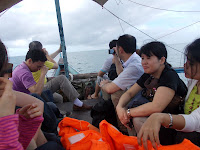







 An unexploited area they called "Intrupahan" was found by BBBRMCI divers with live corals. This area was once visited by the team in 2009 where they conducted coastal
An unexploited area they called "Intrupahan" was found by BBBRMCI divers with live corals. This area was once visited by the team in 2009 where they conducted coastal BBBRMCI is an active Council formed way back in the year 1996 to by the municipalities of Anilao, Banate and Barotac Nuevo in Iloilo, Philippines together with the Iloilo Provincial Government and later joined by Barotac Viejo in 2002. BBBRMCI made a plan for Coastal Resource Management and was implemented and effective through the years until today.









 An unexploited area they called "Intrupahan" was found by BBBRMCI divers with live corals. This area was once visited by the team in 2009 where they conducted coastal
An unexploited area they called "Intrupahan" was found by BBBRMCI divers with live corals. This area was once visited by the team in 2009 where they conducted coastal 





| Length (cm) | Thickness (cm) | Weight (g) | |
| Range: | 3cm - 6.25cm | 1cm - 1.9cm | 2g - 19g |
| AVERAGE: | 4.85 | 1.54 | 10.05 |
Estimated seagrass cover in the five patches located and measured in Barotac Nuevo
| Coordinates | Approximate | |||||
| Area (m2) | ||||||
| BNSg1 | 10°54'54.3"N; 122°48'26.5"E | 477.71 | ||||
| BNSg2 | 10°54'48.4"N; 122°48'26.8"E | 7264.66 | ||||
| BNSg3 | 10°54'42.9"N; 122°48'24.1"E | 480.14 | ||||
| BNSg4 | 10°54'16.9"N; 122°48'28.6"E | 941.61 | ||||
| BNSg5 | 10°54'10.9"N; 122°48'28.7"E | 4560.38 | ||||
| Total | 13,724.49 | |||||
This must have caused the patchiness in the seagrass cover in Barotac Nuevo. If this impact continues, total eradication of seagrasses in the Barotac Nuevo area is very possible in the near future as the remaining patches are already unstable. Gathering of sea cucumber (Holuthuria scabra) was also observed in this area without any regulation as the resource seemed to be free for all. Other organisms observed in the sandy seagrass patches include sea stars (Protoreaster nodosus), bay-ad (Placuna ephippium), small sand dollars and burrowing sea anemone. Fish community in the seagrass beds consists mainly of very small and very few wrasses and goatfishes ranging from 2 cm to 5 cm. Not a single commercially important fish species was observed in the five patches of seagrasses in Barotac Nuevo.
Anilao Coral Garden
The recruited massive corals on the concrete surfaces of the AR units observed during the last monitoring seemed to have grown and already starting to spread. These coral spats seemed to be demonstrating a level of sturdiness to survive the impact of heavy siltation in the area and may be a good indicator that corals, especially massive types, can really thrive in such an area.
Hibotkan Rock Sanctuary
Eleven categories (based on Survey Manual for Tropical Marine Resources by English et al., 1994.) were recorded resulting to a 52 percent live coral cover. Of the live corals, the area was dominated by massive corals (CM) with 23 % cover while branching Acropora (ACB) has the least representatives covering less than 1 % of the total transect length covered. This area is notable for high percentage of tabulate Acropora (ACT) covering around 16 % of the total transect length. Dead corals with algae (DCA) and coral rubbles (R) accounted for a total of around 34% which can be considered high for a protected area like Hibotkan Rock. This may indicate high level of both man-made and natural impacts creating undue stress to the coral reef. As for the abiotic (non-living) component, rocks (RCK) dominate. These rocks are broken pieces from the rock islet itself.
















